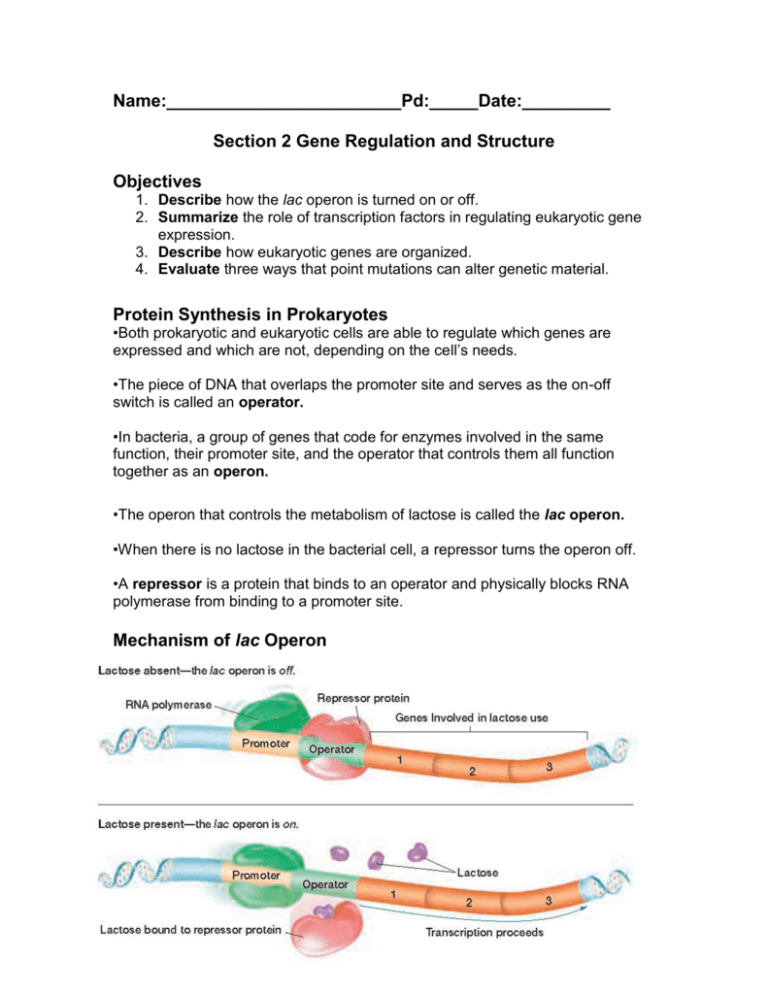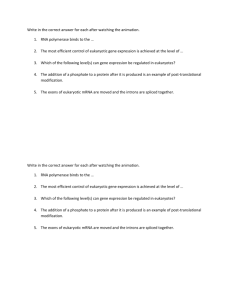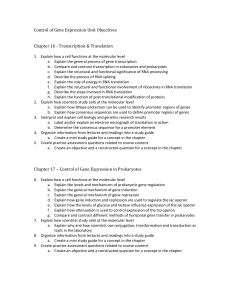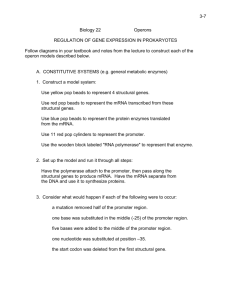NotesCh10Sect2
advertisement

Name:________________________Pd:_____Date:_________ Section 2 Gene Regulation and Structure Objectives 1. Describe how the lac operon is turned on or off. 2. Summarize the role of transcription factors in regulating eukaryotic gene expression. 3. Describe how eukaryotic genes are organized. 4. Evaluate three ways that point mutations can alter genetic material. Protein Synthesis in Prokaryotes •Both prokaryotic and eukaryotic cells are able to regulate which genes are expressed and which are not, depending on the cell’s needs. •The piece of DNA that overlaps the promoter site and serves as the on-off switch is called an operator. •In bacteria, a group of genes that code for enzymes involved in the same function, their promoter site, and the operator that controls them all function together as an operon. •The operon that controls the metabolism of lactose is called the lac operon. •When there is no lactose in the bacterial cell, a repressor turns the operon off. •A repressor is a protein that binds to an operator and physically blocks RNA polymerase from binding to a promoter site. Mechanism of lac Operon Protein Synthesis in Eukaryotes Controlling the Onset of Transcription •Most gene regulation in eukaryotes controls the onset of transcription—when RNA polymerase binds to a gene. •Transcription factors help arrange RNA polymerases in the correct position on the promoter. •An enhancer is a sequence of DNA that can be bound by a transcription factor. Controlling Transcription in Eukaryotes Intervening DNA in Eukaryotic Genes •In eukaryotes, many genes are interrupted by introns—long segments of nucleotides that have no coding information. •Exons are the portions of a gene that are translated (expressed) into proteins. •After a eukaryotic gene is transcribed, the introns in the resulting mRNA are cut out by complex assemblies of RNA and protein called spliceosomes. Removal of Introns After Transcription Mutations •Mutations that move an entire gene to a new location are called gene rearrangements. •Changes in a gene’s position often disrupt the gene’s function because the gene is exposed to new regulatory controls in its new location. •Genes sometimes move as part of a transposon. Other times, the portion of the chromosome containing a gene may be rearranged during meiosis. •Mutations that change a gene are called gene alterations. •In a point mutation, a single nucleotide changes. •In an insertion mutation, a sizable length of DNA is inserted into a gene. •In a deletion mutation, segments of a gene are lost, often during meiosis. •Because the genetic message is read as a series of triplet nucleotides, insertions and deletions of one or two nucleotides can upset the triplet groupings. •A mutation that causes a gene to be read in the wrong threenucleotide sequence is called a frameshift mutation.









